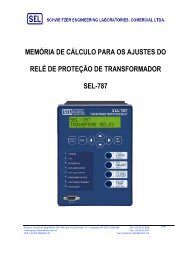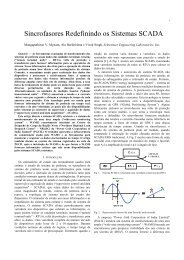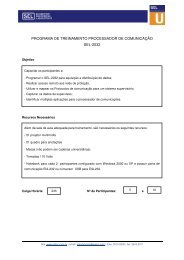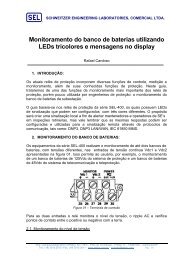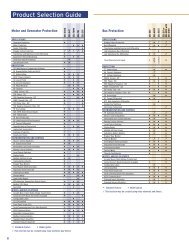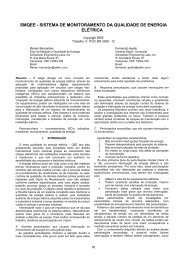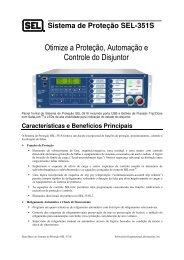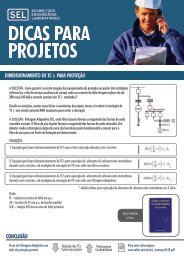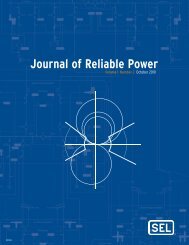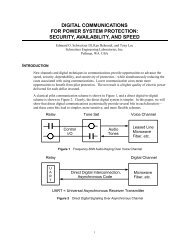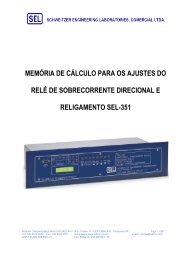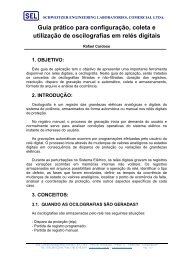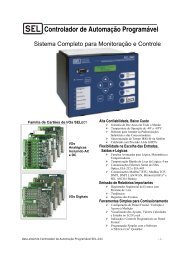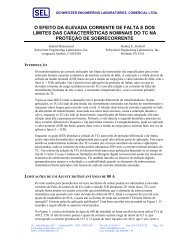Journal of Reliable Power - SEL
Journal of Reliable Power - SEL
Journal of Reliable Power - SEL
You also want an ePaper? Increase the reach of your titles
YUMPU automatically turns print PDFs into web optimized ePapers that Google loves.
15. A POTT scheme implemented over a<br />
19,200 bit/second channel can clear at both ends in<br />
less than one cycle, plus breaker times.<br />
VII. REFERENCES<br />
[1] Shannon, C.E., 1948, “A Mathematical Theory <strong>of</strong> Communication,” The<br />
Bell System Technical <strong>Journal</strong>, Volume XXVII, July.<br />
[2] IEC 834-1, Performance and Testing <strong>of</strong> Teleprotection Equipment <strong>of</strong><br />
<strong>Power</strong> Systems. Part 1: Command Systems, May 1996.<br />
[3] OSD 136L, Optical Systems Design Pty Ltd 7/1 Vuko Place,<br />
Warriewood 2102, NSW Australia; http://www.optsysdesign.com<br />
[4] Haus, Robert J., 1980, Fiber Optics Communications Design Handbook<br />
pg 158. Inglewood Cliffs, New Jersey: Prentice Hall.<br />
[5] Gardner, Terry N., 1998, “<strong>Power</strong> Networking”, Transmission &<br />
Distribution World, February.<br />
[6] Kahler, J. Kraig, “Installation <strong>of</strong> 930-960 MHz Low Density Point-To-<br />
Point Radios and Solid State Relays for Primary Transmission Relay<br />
Protection on 69 kV Transmission Lines,” 21st Annual Western<br />
Protective Relay Conference, Spokane, Washington, October 18–20,<br />
1994.<br />
[7] Roberts, J. and Zimmerman, K, “Trip and Restore Distribution Circuits<br />
at Transmission Speeds,” 25th Annual Western Protective Relay<br />
Conference, Spokane, Washington, October 13–15, 1998.<br />
[8] AT&T Technical Reference TR 63210, “DS0 Digital Local Channel,<br />
Description and Interface Specification,” August 1993.<br />
[9] IEEE Std 487-1992, IEEE Recommended Practice for the Protection <strong>of</strong><br />
Wire-Line Communication Facilities Serving Electric <strong>Power</strong> Stations,<br />
November 4, 1992.<br />
[10] MBT 9600, Pulsar Technologies, Inc., 4050 NW 121st Ave, Coral<br />
Springs, FL 33065; http://www.pulsartech.com.<br />
[11] Schweitzer, E.O. III and Roberts, J, “Distance Relay Element Design,”<br />
19th Annual Western Protective Relay Conference, Spokane,<br />
Washington, October 20–22, 1992.<br />
VIII. APPENDIX A: QUADRILATERAL REACTIVE REACH<br />
VERSUS RESISTIVE REACH SETTING GUIDELINE<br />
A. Quadrilateral Element Review<br />
To pick up a forward-reaching zone <strong>of</strong> quadrilateral ground<br />
distance protection, the relay must determine that the fault<br />
presented to the relay passes the following four measurement<br />
test criteria:<br />
• Reactance < set reactance (top line)<br />
• Apparent fault resistance (RF) < positive-resistance<br />
(right-side) blinder<br />
• RF > negative-resistance (left-side) blinder<br />
• Fault direction is forward as measured by a negative- or<br />
zero-sequence polarized ground directional element<br />
Equations 1 and 2 repeat the equations shown in [11] for<br />
the Zone 1 A-Phase reactance and resistance tests.<br />
R<br />
X<br />
AF<br />
AG1<br />
jT<br />
∗<br />
( A<br />
⋅( R<br />
⋅ ) )<br />
jT<br />
( ) ( )<br />
Im V I e<br />
=<br />
Im Z I k I I e<br />
∗<br />
( 1L<br />
⋅<br />
A<br />
+<br />
0<br />
⋅<br />
R<br />
⋅<br />
R<br />
⋅ )<br />
∗<br />
( A<br />
⋅( 1L<br />
⋅ ( A<br />
+<br />
0<br />
⋅<br />
R ))<br />
)<br />
Im V Z I k I<br />
=<br />
⎛ 3<br />
Im ⎜ ⋅ I<br />
⎝ 2<br />
+ I ⋅ Z ⋅ I + k ⋅ I<br />
( A2 0 ) ( 1L ( A 0 R ))<br />
∗<br />
⎞<br />
⎟<br />
⎠<br />
(1)<br />
(2)<br />
Where:<br />
Im = Imaginary portion<br />
V A = A-Phase voltage, [V]<br />
I A = A-Phase current, [A]<br />
I R = Residual Current (I A + I B + I C ), [A]<br />
Z 1L = Positive-sequence replica line impedance, [Ω]<br />
Z 0L = Zero-sequence replica line impedance, [Ω]<br />
k 0 = (Z 0L - Z 1L )/(3• Z 1L ), [unitless]<br />
I A2 = Neg.-sequence current (I A + a 2 •I B + a•I C ), [A]<br />
I 0 = Zero-sequence current (I R /3), [A]<br />
T = Nonhomogeneous system factor, [degrees]<br />
* = Complex conjugate operator<br />
B. Calculating Reactance Reach As a Function <strong>of</strong> Resistive<br />
Reach<br />
The elements described by Equations (1) and (2) are phase<br />
angle comparators. For the reactance element described by (1),<br />
when the angle between the polarizing quantity (I R ) and the<br />
line drop compensated voltage (Z 1L •(I A + k 0 •I R ) – V) is 0°, the<br />
impedance is on the reactance element boundary. This element<br />
must measure line reactance without under- or overreaching<br />
from the effects <strong>of</strong> load flow or fault resistance. Hence, the<br />
element must use an appropriate polarizing current: negativeand<br />
zero-sequence currents are suitable choices. In some<br />
nonhomogeneous systems, the tip produced by the polarizing<br />
current may be insufficient to prevent overreach. To<br />
compensate for this nonhomogeneity, we introduce polarizing<br />
current angle bias (tip), or reduce the reach <strong>of</strong> the Zone 1<br />
element.<br />
Reducing the Zone 1 reach restricts that portion <strong>of</strong> the line<br />
protected by overlapping instantaneous Zone 1 protection.<br />
This overlapping “zone” is realized for low-resistance faults.<br />
As we show next, a large resistive reach can limit the<br />
reactance element reach when we consider instrumentation<br />
angle errors. If the quadrilateral ground distance elements are<br />
the only Zone 1 protection, then we strike a balance between<br />
overlapping zone for mid-line faults, and large resistive<br />
coverage by one terminal for close-in faults.<br />
Specifically, the instrumentation angle errors we consider<br />
are those due to current transformers (CTs), voltage<br />
transformers (VTs), and the measuring relay. For our example,<br />
the values <strong>of</strong> these angles are: CT = 1°, VT = 2°, Relay<br />
Measurement = 0.2°<br />
Digital Communications for <strong>Power</strong> System Protection: Security, Availability, and Speed | 39



